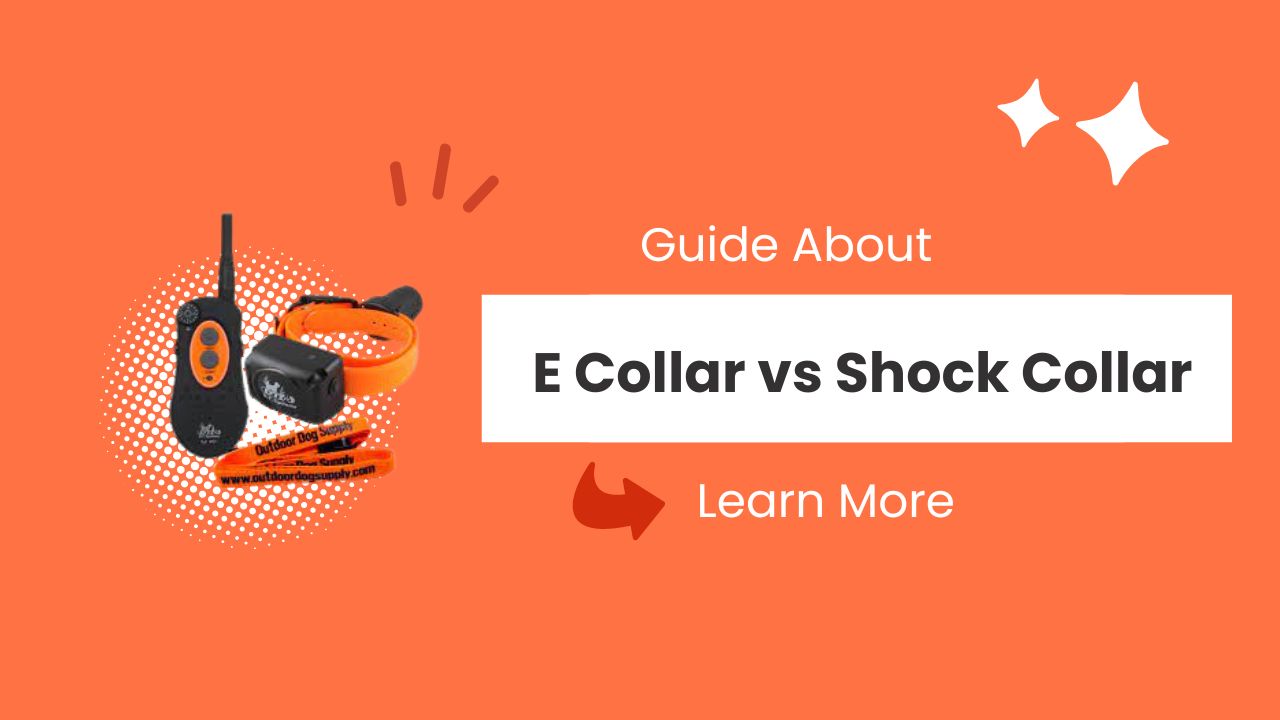As dog owners, we are constantly on the quest for effective and humane ways to train our furry companions, ensuring they lead fulfilling lives while being well-behaved members of the family. In this pursuit, the debate of e-collar vs shock collar surrounding the use of training collars has been a topic of heated discussion.
Two devices often at the center of this controversy are the E collar and the Shock collar, both designed to aid in dog training but with distinct differences in their mechanisms and philosophies.
In this blog post, we delve into the world of canine training devices and explore the key differences between e-collar vs shock collar, aiming to provide clarity on their functionality, impact on dogs’ well-being, and the ethical considerations involved.
By shedding light on this e-collar vs shock, we hope to empower you, as a responsible dog owner, to make an informed decision about the most appropriate training tool for your beloved furry companion.

What is E Collars:
An “e-collar” stands for “electronic collar” or “remote training collar.” It is a device used for training dogs, primarily for teaching them commands and correcting unwanted behaviors. The e-collar consists of a collar that is worn around the dog’s neck and a remote control held by the owner or trainer.
The main purpose of an e-collar is to reinforce positive behaviors and discourage negative behaviors, helping the dog learn commands and become well-behaved.
How E-collars work:
- Remote control: E-collars come with a handheld remote control that allows the trainer to trigger the stimulation or signal when the dog needs to be corrected or guided.
- Stimulation types: The most common form of stimulation is electronic stimulation (shock), but other types like vibration or sound can be used based on the model and training requirements.
- Training association: The dog is trained to associate the stimulation or signal with specific behaviors. For example, a gentle vibration might signal the dog to come back to the trainer, reinforcing the recall command.
Pros of E-collars:
- Safe Stimulation Levels: E-collars are designed to offer a wide range of stimulation levels, allowing trainers to find the most appropriate setting for their dog’s sensitivity. This helps avoid excessive discomfort or harm during training.
- Versatility in Training: These collars are equipped with various training modes, such as vibrations, tones, and adjustable stimulation, making them adaptable to different training needs and behavioral issues.
- Effective for Remote Communication: E-collars enable trainers to communicate with their dogs from a distance, reinforcing commands and addressing behavioral problems even when the dog is off-leash.
Cons of E-collars:
- Potential Misuse and Negative Association: In the wrong hands, e-collars can be misused, leading to negative associations with the collar and causing fear or anxiety in the dog.
- The Need for Proper Training and Knowledge: E-collars should only be used by knowledgeable trainers who understand canine behavior and positive reinforcement techniques. Improper usage can have adverse effects on the dog’s mental well-being.
- Not Suitable for All Dogs: Some dogs may be particularly sensitive to e-collar stimulation, making them unsuitable for this type of training. Each dog’s temperament and needs should be taken into consideration.
When should you use an E-Collar?
Using an E-collar is a decision that requires careful consideration and should not be taken lightly. Here are some situations where E-collars might be used responsibly:
- Off-leash training: E-collars can help reinforce recall and other commands, enabling dogs to have more freedom while ensuring they respond reliably.
- Remote training: In situations where immediate physical control is not possible (e.g., hunting dogs, search and rescue dogs), E-collars can provide essential training cues.
- Behavioral issues: In some cases, trainers and behaviorists might recommend E-collars for addressing specific behavioral problems, but this should be done with professional guidance and as part of a comprehensive training plan.
- Safety: For dogs that exhibit dangerous behaviors like chasing cars or aggressive tendencies, an E-collar might be used to keep them safe and prevent harm.
What Is Shock Collars:
A “shock dog collar” is a training device designed to be worn around a dog’s neck. It is commonly used by some dog owners and trainers to correct unwanted behaviors or reinforce commands. The collar is equipped with electronic components that can deliver a mild electric shock to the dog when activated by a remote control.
The intention behind using a shock dog collar is to provide immediate feedback to the dog, associating certain behaviors with the mild discomfort of the shock. This is meant to discourage the dog from repeating those behaviors in the future
Pros of Shock Collars:
- Immediate Response to Unwanted Behavior: Shock collars deliver a quick and sharp stimulus, which can be effective in interrupting and deterring certain undesirable behaviors.
- Effective in Certain Situations: For working dogs or those undergoing hunting training, shock collars can be valuable tools, ensuring prompt responses to commands in critical situations.
- Ideal for Working Dogs and Hunting Training: Shock collars can enhance the communication between the handler and working dogs, where immediate responses are essential for safety and effectiveness.
Cons of Shock Collars:
- Potential Risk of Overcorrection: If not used carefully, shock collars can lead to overcorrection, causing undue stress and confusion for the dog.
- Possibility of Fear and Anxiety: The use of shock collars may induce fear and anxiety in dogs, leading to more severe behavioral issues if not used with caution.
- Limited Training Scope: Shock collars focus on immediate corrections rather than reinforcing positive behaviors, potentially hindering a well-rounded training approach.
When Should You Use a Shock-Collar
- As a Last Resort: A shock collar should only be considered when all other training methods, such as positive reinforcement and rewards-based training, have been tried and proved ineffective.
- Professional Guidance: If you are considering using a shock collar, it is essential to seek guidance from professional dog trainers who are experienced in its proper and responsible use.
- Specific Training Needs: Shock collars might be used in situations where immediate feedback is necessary, such as off-leash training or preventing potentially dangerous behaviors.
- Dog’s Well-being: Always prioritize the well-being and safety of your dog. The intensity of the shock should be kept at the lowest level possible, ensuring it does not cause harm or distress.
Understanding the Key Differences:
E-collar (Electronic Collar): An electronic training device worn around a dog’s neck, used to reinforce commands and correct behaviors with gentle signals like vibrations or sounds.
Shock Collar: Also known as a “shock dog collar,” it’s an electronic collar that delivers a mild electric shock to a dog when activated by a remote control, aimed at correcting behaviors.
Factors to Consider When Choosing the Right Training Aid:
When deciding between an E Collar vs a Shock Collar, several factors demand consideration. Your dog’s breed, age, temperament, and the specific behavioral issues you wish to address play a pivotal role.
Consulting with a professional dog trainer can provide valuable insights tailored to your pet’s unique needs.
Tips for Successful Training with E Collars or Shock Collars Introducing any training aid requires patience, consistency, and a thorough understanding of the tool. Begin with the lowest stimulation level and gradually increase it if necessary.
Combine collar training with positive reinforcement to reinforce positive behaviors and build a stronger bond with your furry companion.

Conclusion of E-Collar Vs Shock Collar:
When considering whether to use an e-collar or shock collar for your dog’s training, prioritize their safety, well-being, and individual needs.
E-collars offer versatile options with adjustable stimulation levels and can be useful for remote communication, while shock collars provide immediate responses in specific situations.
However, the key lies in responsible usage, proper training, and incorporating positive reinforcement techniques to create a well-rounded and effective training approach for your furry companion.
FAQs:
Q: Are e-collars and shock collars the same?
A: No, e-collars and shock collars are different. E-collars offer various training modes like vibrations and tones, while shock collars deliver quick electric stimuli.
Q: Are shock collars safe for dogs?
A: When used responsibly and in conjunction with proper training, shock collars can be safe. However, misuse can lead to negative effects on a dog’s well-being.
Q: Can e-collars be used for all dog breeds?
A: E-collars may not be suitable for all dogs, as each dog’s temperament and sensitivity levels differ. Consult a professional trainer to assess the best option for your dog.
Q: Are Shock Collars cruel?
A: Modern Shock Collars with milder stimulation are considered more humane, but responsible usage is essential to avoid potential harm.

